初中英语八种时态归纳表格
- 格式:doc
- 大小:47.00 KB
- 文档页数:2

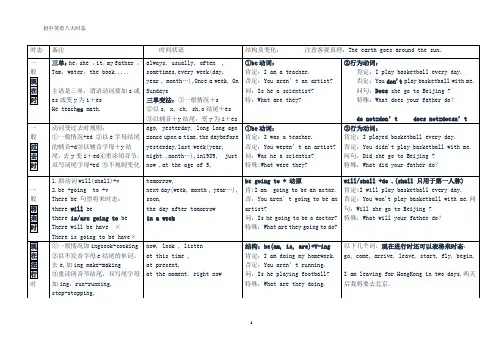
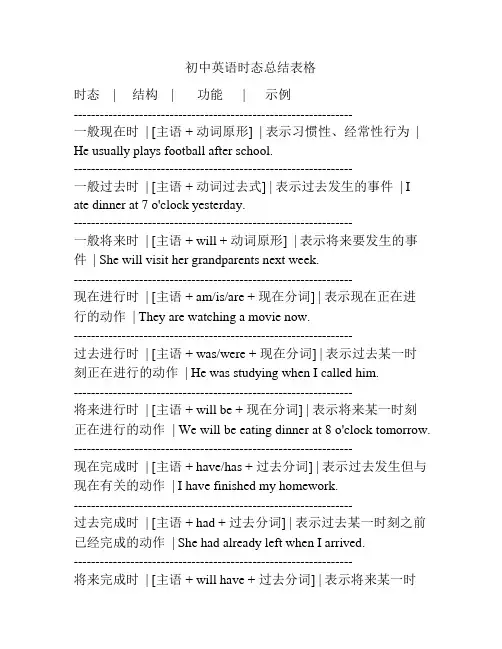
初中英语时态总结表格时态 | 结构 | 功能 | 示例----------------------------------------------------------------一般现在时 | [主语 + 动词原形] | 表示习惯性、经常性行为 | He usually plays football after school.----------------------------------------------------------------一般过去时 | [主语 + 动词过去式] | 表示过去发生的事件 | I ate dinner at 7 o'clock yesterday.----------------------------------------------------------------一般将来时 | [主语 + will + 动词原形] | 表示将来要发生的事件 | She will visit her grandparents next week.----------------------------------------------------------------现在进行时 | [主语 + am/is/are + 现在分词] | 表示现在正在进行的动作 | They are watching a movie now.----------------------------------------------------------------过去进行时 | [主语 + was/were + 现在分词] | 表示过去某一时刻正在进行的动作 | He was studying when I called him.----------------------------------------------------------------将来进行时 | [主语 + will be + 现在分词] | 表示将来某一时刻正在进行的动作 | We will be eating dinner at 8 o'clock tomorrow. ----------------------------------------------------------------现在完成时 | [主语 + have/has + 过去分词] | 表示过去发生但与现在有关的动作 | I have finished my homework.----------------------------------------------------------------过去完成时 | [主语 + had + 过去分词] | 表示过去某一时刻之前已经完成的动作 | She had already left when I arrived.----------------------------------------------------------------将来完成时 | [主语 + will have + 过去分词] | 表示将来某一时刻之前已经完成的动作 | By this time next year, we will have graduated from high school.----------------------------------------------------------------情态动词 | [情态动词 + 动词原形] | 表示能力、意愿、推测等 | She can swim very well.----------------------------------------------------------------。
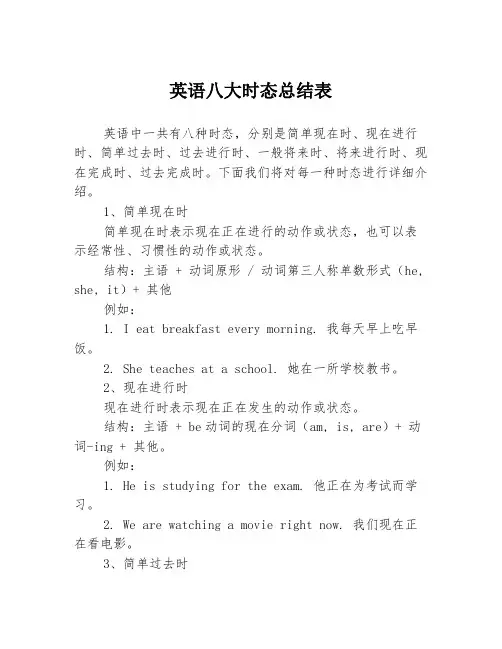
英语八大时态总结表英语中一共有八种时态,分别是简单现在时、现在进行时、简单过去时、过去进行时、一般将来时、将来进行时、现在完成时、过去完成时。
下面我们将对每一种时态进行详细介绍。
1、简单现在时简单现在时表示现在正在进行的动作或状态,也可以表示经常性、习惯性的动作或状态。
结构:主语 + 动词原形 / 动词第三人称单数形式(he, she, it)+ 其他例如:1. I eat breakfast every morning. 我每天早上吃早饭。
2. She teaches at a school. 她在一所学校教书。
2、现在进行时现在进行时表示现在正在发生的动作或状态。
结构:主语 + be动词的现在分词(am, is, are)+ 动词-ing + 其他。
例如:1. He is studying for the exam. 他正在为考试而学习。
2. We are watching a movie right now. 我们现在正在看电影。
3、简单过去时简单过去时表示在过去某个时间发生的动作或状态。
结构:主语 + 动词的过去式 / 动词的第二人称单数形式(you)+ 其他。
例如:1. They went to the beach last summer. 他们去年夏天去了海滩。
2. She talked to her friend on the phone yesterday. 她昨天给她的朋友打电话聊天了。
4、过去进行时过去进行时表示过去某个时间正在进行的动作或状态。
结构:主语 + be动词的过去分词(was, were)+ 动词的现在分词(-ing)+ 其他例如:1. They were playing soccer when it started raining. 下雨的时候他们正在踢足球。
2. She was studying when her phone rang. 她在学习的时候接到了电话。
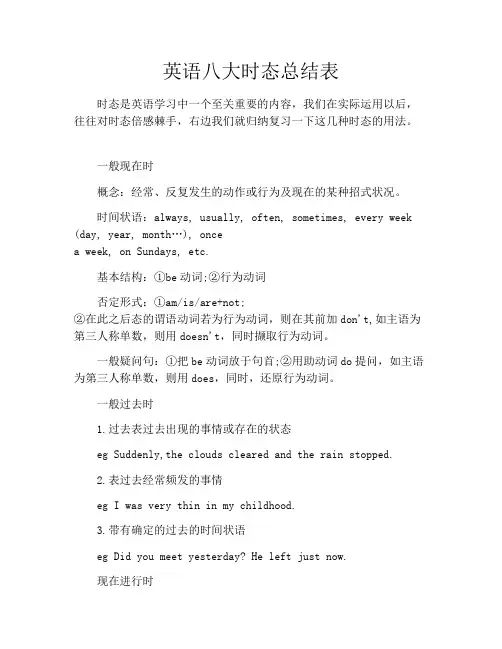
英语八大时态总结表时态是英语学习中一个至关重要的内容,我们在实际运用以后,往往对时态倍感棘手,右边我们就归纳复习一下这几种时态的用法。
一般现在时概念:经常、反复发生的动作或行为及现在的某种招式状况。
时间状语:always, usually, often, sometimes, every week (day, year, month…), oncea week, on Sundays, etc.基本结构:①be动词;②行为动词否定形式:①am/is/are+not;②在此之后态的谓语动词若为行为动词,则在其前加don't,如主语为第三人称单数,则用doesn't,同时撷取行为动词。
一般疑问句:①把be动词放于句首;②用助动词do提问,如主语为第三人称单数,则用does,同时,还原行为动词。
一般过去时1.过去表过去出现的事情或存在的状态eg Suddenly,the clouds cleared and the rain stopped.2.表过去经常频发的事情eg I was very thin in my childhood.3.带有确定的过去的时间状语eg Did you meet yesterday? He left just now.现在进行时1.说话、写文章的当刻正在暴发的动作eg They are having a football match.2.现阶段一直在成功进行的动作eg He is preparing for CET Band Six.3.表示说话人的情感,如赞许、批评等eg She is often doing well at school.4.表示在近期按计划或安排要发生的动作eg Are you staying here till next week?过去进行时1.概念:表示过去某段时间或某一时刻正在发生或进行的行为或动作。
2.时间状语:at this time yesterday, at that time或以when 引导状语的谓语宾语是一般过去时的时间状语等。
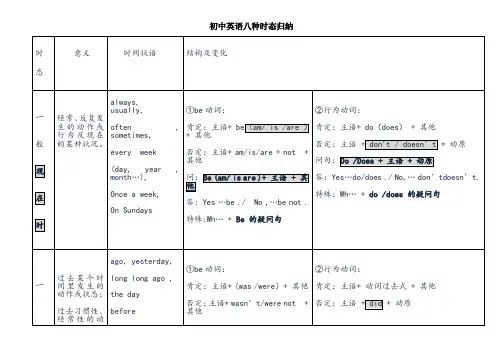

初中时态语态总结表格初中时态语态总结表格动词形式一般现在时一般过去时一般将来时完成时态进行时态被动语态一般形式 V原形+s/es V-ed will/shall+V原形have/has+V过去分词 am/is/are+V-ing am/is/are+V过去分词例句 She plays basketball. He studied English yesterday. I will go to the beach tomorrow. They have finished their homework. I am watching TV now. The book was written by Mark.时态解释表示现在发生的动作或状态。
表示过去发生的动作或状态。
表示将来发生的动作或状态。
表示过去发生并一直延续到现在的动作或状态。
表示说话时正在进行的动作或状态。
表示动作的承受者。
一般性使用主语+动词主语+动词ed 主语+will/shall+动词主语+have/has+动词ed 主语+am/is/are+动词ing 主语+am/is/are+动词过去分词一般疑问句助动词(do/does)/be动词(is/am/are)+主语+动词助动词(did)/be动词(was/were)+主语+动词助动词(will/shall)/be动词(is/am/are)+主语+动词助动词(have/has)/be动词(is/am/are)+主语+动词ed 助动词(am/is/are)/be动词(is/am/are)+主语+ 动词ing 助动词(am/is/are)/be动词(is/am/are)+主语+动词过去分词特殊疑问句疑问词+助动词(do/does)/be动词(is/am/are)+主语+动词疑问词+助动词(did)/be动词(was/were)+主语+动词疑问词+助动词(will/shall)/be 动词(is/am/are)+主语+动词疑问词+助动词(have/has)/be动词(is/am/are)+主语+动词ed 疑问词+助动词(am/is/are)/be动词(is/am/are)+主语+ 动词ing 疑问词+助动词(am/is/are)/be动词(is/am/are)+主语+动词过去分词否定句主语+助动词(do not/does not)/be动词(is/am/are not)+动词主语+助动词(did not)/be动词(was/were not)+动词主语+助动词(will/shall not)/be动词(is/am/are not)+动词主语+助动词(have/has not)/be 动词(is/am/are not)+动词ed 主语+助动词(am not/is not/are not)/be动词(is/am/are not)+动词ing 主语+助动词(am not/is not/are not)/be动词(is/am/are not)+动词过去分词情态动词主语+情态动词+动词原形主语+情态动词+动词原形主语+will/shall+情态动词+动词原形主语+have/has+情态动词+动词原形主语+am/is/are+情态动词+ 动词ing 主语+am/is/are+情态动词+动词过去分词现在进行时主语+am/is/are+V-ing 主语+was/were+V-ing 主语+will/shall+be+V-ing 主语+have/has+been+V-ing - -过去进行时主语+was/were+V-ing -- - - -将来进行时主语+will/shall+be+V-ing -- - - -完成进行时主语+have/has+been+V-ing 主语+had+been+V-ing - -- -被动语态主语+am/is/are+V过去分词主语+was/were+V过去分词主语+will/shall+be+V过去分词主语+have/has+been+V过去分词主语+am/is/are+being+V过去分词主语+am/is/are+V过去分词。
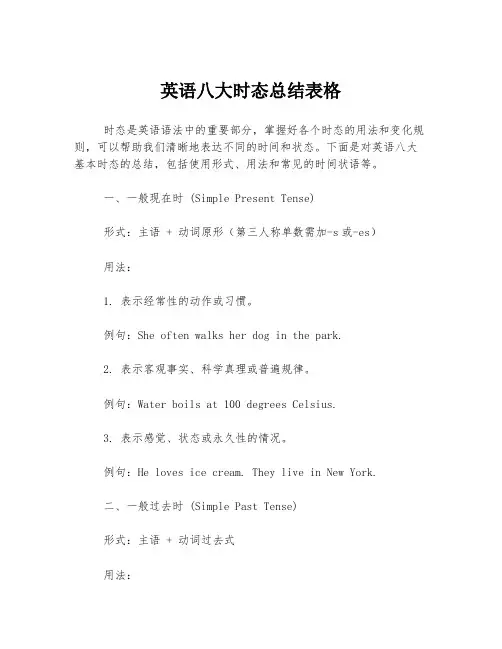
英语八大时态总结表格时态是英语语法中的重要部分,掌握好各个时态的用法和变化规则,可以帮助我们清晰地表达不同的时间和状态。
下面是对英语八大基本时态的总结,包括使用形式、用法和常见的时间状语等。
一、一般现在时 (Simple Present Tense)形式:主语 + 动词原形(第三人称单数需加-s或-es)用法:1. 表示经常性的动作或习惯。
例句:She often walks her dog in the park.2. 表示客观事实、科学真理或普遍规律。
例句:Water boils at 100 degrees Celsius.3. 表示感觉、状态或永久性的情况。
例句:He loves ice cream. They live in New York.二、一般过去时 (Simple Past Tense)形式:主语 + 动词过去式用法:1. 表示过去某个具体时间发生的动作或事件。
例句:She went to Paris last summer.2. 表示过去经常发生的动作或习惯。
例句:He always ate breakfast at home.3. 表示过去的状态或情况,通常和表示时间的副词连用。
例句:It rained heavily yesterday.三、一般将来时 (Simple Future Tense)形式:主语 + will/shall + 动词原形用法:1. 表示将来的意愿、打算或决定。
例句:I will help you with your homework.2. 表示将来发生的动作或事件,没有具体的时间。
例句:They will arrive tomorrow.3. 表示预测、推测或假设。
例句:It will probably rain this evening.四、现在进行时 (Present Continuous Tense)形式:主语 + am/is/are + 现在分词用法:1. 表示正在进行或发生的动作。
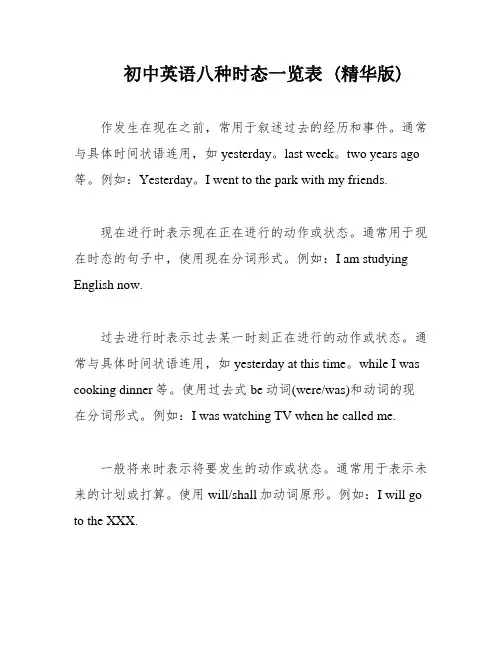
初中英语八种时态一览表 (精华版)作发生在现在之前,常用于叙述过去的经历和事件。
通常与具体时间状语连用,如yesterday。
last week。
two years ago 等。
例如:Yesterday。
I went to the park with my friends.现在进行时表示现在正在进行的动作或状态。
通常用于现在时态的句子中,使用现在分词形式。
例如:I am studying English now.过去进行时表示过去某一时刻正在进行的动作或状态。
通常与具体时间状语连用,如yesterday at this time。
while I was cooking dinner等。
使用过去式be动词(were/was)和动词的现在分词形式。
例如:I was watching TV when he called me.一般将来时表示将要发生的动作或状态。
通常用于表示未来的计划或打算。
使用will/shall加动词原形。
例如:I will go to the XXX.过去将来时表示过去某个时间点将要发生的动作或状态。
通常与具体时间状语连用,使用过去式be动词(were/was)和动词的原形。
例如:Yesterday at this time。
I was going to theparty with my friends.现在完成时表示过去发生的动作对现在的影响或过去延续到现在的动作或状态。
使用have/has加动词的过去分词形式。
例如:I have finished my homework。
so I can relax now.过去完成时表示过去某个时间点之前已经完成的动作或状态。
通常与具体时间状语连用,使用had加动词的过去分词形式。
例如:By the time I arrived。
he had already left.需要使用连词that来引导。
When writing an article。
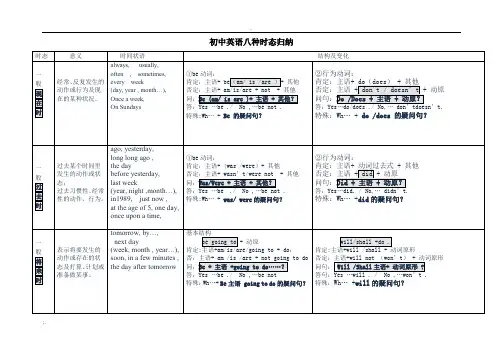
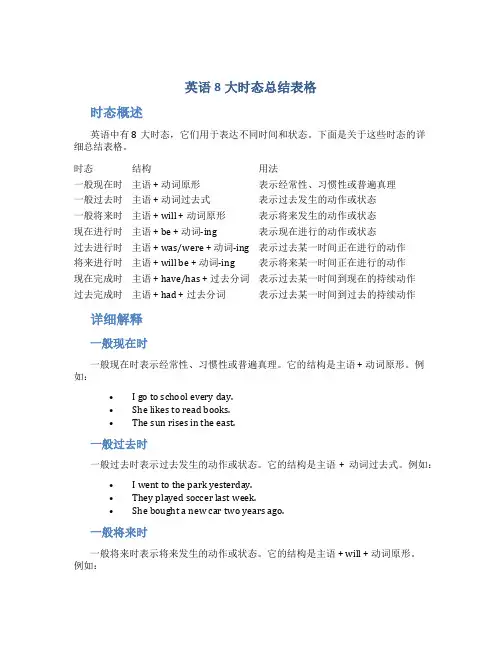
英语8大时态总结表格时态概述英语中有8大时态,它们用于表达不同时间和状态。
下面是关于这些时态的详细总结表格。
时态结构用法一般现在时主语 + 动词原形表示经常性、习惯性或普遍真理一般过去时主语 + 动词过去式表示过去发生的动作或状态一般将来时主语 + will + 动词原形表示将来发生的动作或状态现在进行时主语 + be + 动词-ing 表示现在进行的动作或状态过去进行时主语 + was/were + 动词-ing 表示过去某一时间正在进行的动作将来进行时主语 + will be + 动词-ing 表示将来某一时间正在进行的动作现在完成时主语 + have/has + 过去分词表示过去某一时间到现在的持续动作过去完成时主语 + had + 过去分词表示过去某一时间到过去的持续动作详细解释一般现在时一般现在时表示经常性、习惯性或普遍真理。
它的结构是主语 + 动词原形。
例如:•I go to school every day.•She likes to read books.•The sun rises in the east.一般过去时一般过去时表示过去发生的动作或状态。
它的结构是主语+ 动词过去式。
例如:•I went to the park yesterday.•They played soccer last week.•She bought a new car two years ago.一般将来时一般将来时表示将来发生的动作或状态。
它的结构是主语 + will + 动词原形。
例如:•I will travel to Japan next month.•They will have a party tomorrow.•She will call you later.现在进行时现在进行时表示现在正在进行的动作或状态。
它的结构是主语+ be + 动词-ing。
例如:•I am studying for the exam.•She is watching TV right now.•They are playing basketball in the park.过去进行时过去进行时表示过去某一时间正在进行的动作。
展宏学校中考英语常考八大时态与被动语态类别一般现在时现在进行时现在完成时一般将来时用途谓语结构(动词形式 ) 被动结构时态标志1.表示经常性、习惯性的动作;表示现在(说话瞬间)正2.表示客观事实或永恒真理;在进行或发生的动作。
3.表示特征、爱好、状态和能力等。
V.原或 V.三单 (he/she/it 或能够用he/she/it 代替的人或物后用三单 )am / is / are + 过分am / is / are +being+过分1. 频率副词: often;sometimes=(at 1. now = at present = righttimes); always; usually; every day now = at the moment(every + 时间 ) 2. look, listen开头的句2. 次数: twice a week子。
3. on Sundays:在每一个星期天例句 :例句 :She is watering the treesHe often cleans the room. 主(动 )now. (主动 )The roomoften by him.The trees by(被动 )her now. (被动 )1. 表示发生在过去的动表示将来某个时间要发生的作一直持续到现在; 2.动作或存在的状态。
表示发生在过去的动作对现在造成的影响或结果。
have/has + 过分 1.will + V .原2.be going to + V.原have / has been + 过分will be + 过分1. for / since+时间; 1.将来的时间: tomorrow;the day2. 副词 ever, never, yet,after tomorrow;next week ;in a fewalready 等;days;in 3 years;in the future ;this3. so far = by now=up to evening/year/weeknow; 2. at once=in a minute=right away3.soon4.in the last/past few 例句 :years;She will do it tomorrow. ( 主动 )It by her5.over the years= in tomorrow. (被动 )recent years在主从复合句中,当主句为一般将来It ’s 7 o’clock + 现在进行时、主句为祈使句、主句含有情态动时。
以下是初中英语语法八大时态总结表格:时态用法构成时间状语一般现在时表示经常发生的动作或存在的状态主语+动词原形/第三人称单数形式+其他always, usually, often,sometimes, everyday/week/month/year, etc.一般过去时表示过去发生的动作或存在的状态主语+动词过去式+其他yesterday, lastweek/month/year, etc.现在进行时表示现在正在进行的动作主语+am/is/are+现在分词+其他now, at the moment, etc.过去进行时表示过去某个时刻正在进行的动作主语+was/were+现在分词+其他at this time yesterday,etc.一般将来时表示将要发生的动作或存在的状态主语+will/shall+动词原形+其他tomorrow, nextweek/month/year, etc.过去将来时表示过去将要发生的动作或存在的状态主语+would/should+动词原形+其他the next day, etc.时态用法构成时间状语现在完成时表示过去发生的动作对现在造成的影响或结果主语+have/has+过去分词+其他already, yet, ever, never,for/since, etc.过去完成时表示过去某个时间之前已经完成的动作主语+had+过去分词+其他by the time, before, etc.需要注意的是,这些时态的构成和用法可能会有一些例外情况,具体取决于语境和句子结构。
此外,不同的教材和地区可能会有一些差异,因此在学习过程中,建议你参考多种资料,以便更好地理解和掌握这些时态。